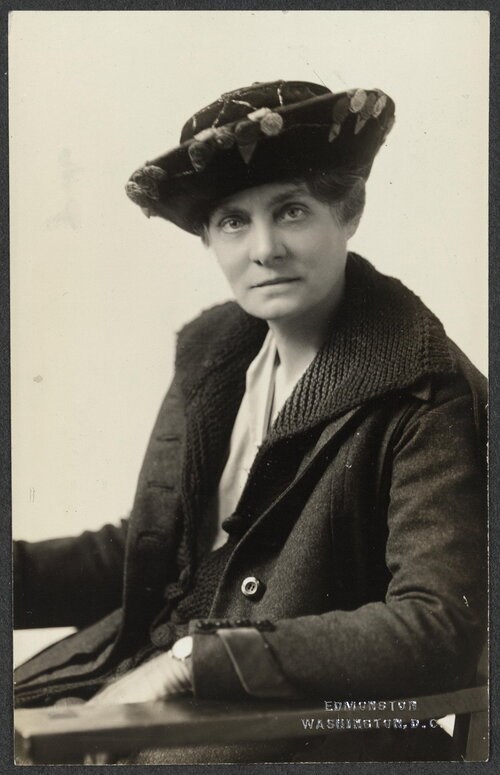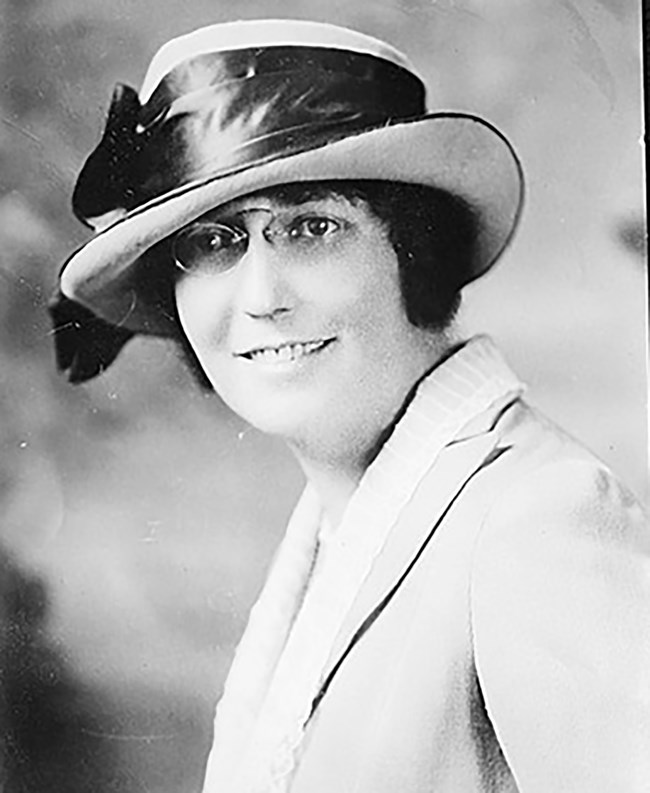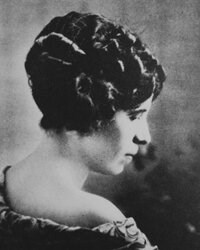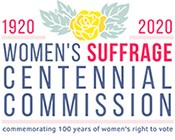Part of a series of articles titled On Their Shoulders: The Radical Stories of Women's Fight for the Vote.
Article
Suffrage in Spanish: Hispanic Women and the Fight for the 19th Amendment in New Mexico
By Cathleen D. Cahill
At three o'clock on an October afternoon in 1915, the suffragists of Santa Fe, New Mexico, took to the streets of the capital city to make "a public act of faith in the cause of woman suffrage." One hundred and fifty women joined the parade, Anglos (the term New Mexicans used to refer to whites) and Hispanics (which referred to the Spanish-speaking citizens of the state). Some marched; others rode in gaily decorated automobiles. Mrs. Trinidad Cabeza de Baca, whose family owned one of the first autos in the city, lent hers to the cause. She was joined by a number of other Hispanic women, including Dolores "Lola" Armijo, Mrs. James Chavez, Aurora Lucero, Anita (Mrs. Secundino) Romero, Arabella (Mrs. Cleofas) Romero and her daughter, Marie.[1]
At three o'clock on an October afternoon in 1915, the suffragists of Santa Fe, New Mexico, took to the streets of the capital city to make "a public act of faith in the cause of woman suffrage." One hundred and fifty women joined the parade, Anglos (the term New Mexicans used to refer to whites) and Hispanics (which referred to the Spanish-speaking citizens of the state). Some marched; others rode in gaily decorated automobiles. Mrs. Trinidad Cabeza de Baca, whose family owned one of the first autos in the city, lent hers to the cause. She was joined by a number of other Hispanic women, including Dolores "Lola" Armijo, Mrs. James Chavez, Aurora Lucero, Anita (Mrs. Secundino) Romero, Arabella (Mrs. Cleofas) Romero and her daughter, Marie.[1]

The story of these New Mexicans reminds us of the diversity of suffrage activism in the United States. Their advocacy for the vote grew out of their insistence that Spanish-Americans, as they called themselves, were equal citizens. At a moment when the land rights, religion, and language of Hispanics were under attack, they asserted that the suffrage movement needed to include them and their concerns. Spanish-speakers constituted more than half of the population of the state and held political power as voters. Their position as economically secure and politically connected Hispanic women made them a force to be reckoned with. White suffragists therefore listened to them and incorporated their ideas, offering a model of cooperation for today's multicultural society (though it is vital to note that Native American women in New Mexico were not included in this cooperation; more on this will be explored below, as well as in my forthcoming article in this series, “Indigenous Women in the Suffrage Movement”).

The parade coincided with a visit from Mrs. Ella St. Clair Thompson, an organizer from the National Woman's Party (NWP, known until 1916 as the Congressional Union). The NWP had been founded by Alice Paul and focused on securing an amendment that prohibited voting discrimination based on sex. Unlike women in the rest of the American West, suffragists in New Mexico focused on a national amendment, rather than a state law. Although they had fought for full suffrage to be included in the constitution when New Mexico became a state in 1912, they had been unsuccessful. Also, in order to protect the Spanish language provisions and religious freedoms for Catholics written into the document, the members of the constitutional convention had deliberately made the constitution extremely hard to amend. Any changes required the votes of two-thirds of the legislators, followed by three-fourths voter approval in each county. While the men of the convention had included women’s voting rights in school elections in the constitution, women could not vote in other elections.

The 1915 Santa Fe suffrage parade is a good example of American women's cooperation across ethnic lines. They concluded the march at the house of U.S. Senator Thomas Catron (R-NM), a notorious anti-suffragist. They had designated four women – two Anglos and two Hispanic women, the latter Aurora Lucero and Arabella Romero – to give speeches formally asking the Senator to support the federal amendment when he returned to Washington. He declined and lectured the women at great length on why they were wrong to demand the vote. Nevertheless, their cause gained great visibility in the capital and in the press coverage.[3]
The next year, New Mexican women formed an official state branch of the NWP and elected Nina Otero-Warren as state vice-chair. When the first chair stepped down, Otero-Warren took her place at Alice Paul's request. Otero-Warren was politically well-connected and respected throughout the state for her educational work. Her father had been an influential local leader before he had been murdered by Anglo squatters on his land grant. Her stepfather's later political appointment brought her family to live in Santa Fe where her maternal uncle was a major politician who had played a key role during the state constitutional convention. She used those connections in her fight for suffrage and also played a key role in ensuring that the state legislature ratified the 19th Amendment in February 1920. Although it had seemed like certain victory, there was a last-minute difficulty with wavering legislators. Otero-Warren fiercely lobbied, using her new position as chair of the GOP state women's committee to caucus with legislators and discipline their votes.

After ratification of the 19th Amendment, the Democrat and Republican parties in New Mexico appealed to newly enfranchised female voters by nominating women to run for office. Otero-Warren's experience as a suffrage campaigner and her family's strong political connections prompted the Republican party to nominate her as their Congressional candidate in 1922. Her campaign made national headlines, beginning when she beat the male incumbent in the primary, though she narrowly lost in the main election. That same year the Democrats also nominated two women, one Anglo and one Hispanic, for state office. Their candidate for secretary of state, Soledad Chávez de Chacón, won, becoming the first woman in the nation to win election for that office.
The experience of New Mexican Hispanic women was unusual. The demographics of New Mexico gave Spanish-speakers a political advantage they did not have in other states. The result has been that New Mexico has a long tradition of electing Hispanic women, including the first two Hispanic women governors: Republican Susana Martinez (2011-2019) and Democrat Michelle Lujan Grisham (Incumbent). In contrast, Mexican-Americans in Texas did not have the same political clout. Moreover, most of them were poor sharecroppers who were disenfranchised by Jim Crow laws, like the poll tax as well as extra-legal threats of violence.
New Mexico's Hispanic women's advocacy of suffrage and their work with the National Woman's Party reminds us that Spanish was also a language of suffrage. Armed with economic security and the political clout of long-established Spanish-speaking families, New Mexico’s Hispanic women represented a formidable political force. Without New Mexico as one of the thirty-six states that ratified the Amendment, it may well not have passed. And the state's vote to ratify would not have happened without the support of the Hispanic community or the advocacy work of Hispanic suffragists.

Author Biography
Cathleen D. Cahill is an associate professor of history at Penn State University. She is a social historian who explores the everyday experiences of ordinary people, primarily women. She focuses on women's working and political lives, asking how identities such as race, nationality, class, and age have shaped them. She is also interested in the connections generated by women's movements for work, play, and politics, and how mapping those movements reveal women in surprising and unexpected places. She is the author of Federal Fathers and Mothers: A Social History of the United States Indian Service, 1869–1932 (University of North Carolina Press, 2011), which won the Labriola Center American Indian National Book Award and was a finalist for the David J. Weber and Bill Clements Book Prize. Her most recent book, Recasting the Vote: How Women of Color Transformed the Suffrage Movement (University of North Carolina Press, Fall 2020) follows the lead of feminist scholars of color calling for alternative "genealogies of feminism." It is a collective biography of six suffragists--Yankton Dakota Sioux author and activist Gertrude Bonnin (Zitkala-Ša); Wisconsin Oneida writer Laura Cornelius Kellogg; Turtle Mountain Chippewa and French lawyer Marie Bottineau Baldwin; African American poet and clubwoman Carrie Williams Clifford; Mabel Ping-Hua Lee, the first Chinese woman in the United States to earn her PhD ; and New Mexican Hispana politician and writer Nina Otero-Warren--both before and after the ratification of the Nineteenth Amendment. She also serves on the advisory committee for the national Votes for Women Trail and is the steering committee chair of the Coalition for Western Women's History.
Footnotes
[1] Census of 1910 lists Cleofas, Arabella, and Marie as residents of Las Vegas, but Cleofas was the superintendent of the state petitionary in Santa Fe. Year: 1910; Census Place: Las Vegas Ward 3, San Miguel, New Mexico; Roll: T624_917; Page: 5B; Enumeration District: 0197; FHL microfilm: 1374930. A newspaper article suggests Arabella and Anita Romero were sisters-in-law. See "Appointments by Governor," Albuquerque Morning Journal, March 2, 1917.
[2] "150 Santa Fe Suffragists in Demonstration at Home of U.S. Senator Catron," Santa Fe New Mexican, October 21, 1915.
[3] Ibid.
Bibliography
Andrés Jr., Benny. “Chacón, Soledad Chávez (1890-1936)." In Latinas in the United States: A Historical Encyclopedia edited by Vicki L. Ruiz and Virginia Sánchez Korrol. 143-144 (Bloomington: Indiana University Press, 2006)
Crandall, Maurice S., These People Have Always Been a Republic: Indigenous Electorates in the US-Mexico Borderlands, 1598-1912 (Chapel Hill: University of North Carolina Press, 2019)
Francis-Fallon, Benjamin. The Rise of the Latino Vote: A History (Cambridge: Harvard University Press, 2019)
Hellwege, Julia Marin and Christine Marie Sierra. "Advantages and Disadvantages for Latina Officeholders: The Case of New Mexico." In Latinas in American Politics: Changing and Embracing Political Tradition. Sharon A. Navarro, Samantha L. Hernandez and Leslie A. Navarro, eds. (Lanham, Maryland: Lexington Press, 2016)
Jensen, Joan M. “'Disenfranchisement is a Disgrace': Women and Politics in New Mexico, 1900- 1940.” New Mexico Historical Review 56, no. 1 (January 1, 1981): 5-35.
Lozano, Rosina, An American Language: A History of Spanish in the United States (University of California Press, 2018)
Orozco, Cynthia E. No Mexicans, Women, or Dogs Allowed: The Rise of the Mexican American Civil Rights Movement (Austin: University of Texas Press, 2009)
Whaley, Charlotte. Nina Otero-Warren of Santa Fe (Santa Fe: Sunstone Press, 2007)
Cathleen D. Cahill is an associate professor of history at Penn State University. She is a social historian who explores the everyday experiences of ordinary people, primarily women. She focuses on women's working and political lives, asking how identities such as race, nationality, class, and age have shaped them. She is also interested in the connections generated by women's movements for work, play, and politics, and how mapping those movements reveal women in surprising and unexpected places. She is the author of Federal Fathers and Mothers: A Social History of the United States Indian Service, 1869–1932 (University of North Carolina Press, 2011), which won the Labriola Center American Indian National Book Award and was a finalist for the David J. Weber and Bill Clements Book Prize. Her most recent book, Recasting the Vote: How Women of Color Transformed the Suffrage Movement (University of North Carolina Press, Fall 2020) follows the lead of feminist scholars of color calling for alternative "genealogies of feminism." It is a collective biography of six suffragists--Yankton Dakota Sioux author and activist Gertrude Bonnin (Zitkala-Ša); Wisconsin Oneida writer Laura Cornelius Kellogg; Turtle Mountain Chippewa and French lawyer Marie Bottineau Baldwin; African American poet and clubwoman Carrie Williams Clifford; Mabel Ping-Hua Lee, the first Chinese woman in the United States to earn her PhD ; and New Mexican Hispana politician and writer Nina Otero-Warren--both before and after the ratification of the Nineteenth Amendment. She also serves on the advisory committee for the national Votes for Women Trail and is the steering committee chair of the Coalition for Western Women's History.
Footnotes
[1] Census of 1910 lists Cleofas, Arabella, and Marie as residents of Las Vegas, but Cleofas was the superintendent of the state petitionary in Santa Fe. Year: 1910; Census Place: Las Vegas Ward 3, San Miguel, New Mexico; Roll: T624_917; Page: 5B; Enumeration District: 0197; FHL microfilm: 1374930. A newspaper article suggests Arabella and Anita Romero were sisters-in-law. See "Appointments by Governor," Albuquerque Morning Journal, March 2, 1917.
[2] "150 Santa Fe Suffragists in Demonstration at Home of U.S. Senator Catron," Santa Fe New Mexican, October 21, 1915.
[3] Ibid.
Bibliography
Andrés Jr., Benny. “Chacón, Soledad Chávez (1890-1936)." In Latinas in the United States: A Historical Encyclopedia edited by Vicki L. Ruiz and Virginia Sánchez Korrol. 143-144 (Bloomington: Indiana University Press, 2006)
Crandall, Maurice S., These People Have Always Been a Republic: Indigenous Electorates in the US-Mexico Borderlands, 1598-1912 (Chapel Hill: University of North Carolina Press, 2019)
Francis-Fallon, Benjamin. The Rise of the Latino Vote: A History (Cambridge: Harvard University Press, 2019)
Hellwege, Julia Marin and Christine Marie Sierra. "Advantages and Disadvantages for Latina Officeholders: The Case of New Mexico." In Latinas in American Politics: Changing and Embracing Political Tradition. Sharon A. Navarro, Samantha L. Hernandez and Leslie A. Navarro, eds. (Lanham, Maryland: Lexington Press, 2016)
Jensen, Joan M. “'Disenfranchisement is a Disgrace': Women and Politics in New Mexico, 1900- 1940.” New Mexico Historical Review 56, no. 1 (January 1, 1981): 5-35.
Lozano, Rosina, An American Language: A History of Spanish in the United States (University of California Press, 2018)
Orozco, Cynthia E. No Mexicans, Women, or Dogs Allowed: The Rise of the Mexican American Civil Rights Movement (Austin: University of Texas Press, 2009)
Whaley, Charlotte. Nina Otero-Warren of Santa Fe (Santa Fe: Sunstone Press, 2007)
Tags
- belmont-paul women's equality national monument
- women's rights national historical park
- women's history
- political history
- new mexico
- suffrage
- 19th amendment
- civil rights
- latino history
- hispanic history
- native american history
- american indian history
- religious history
- women's rights
- women in government
Last updated: October 29, 2021
